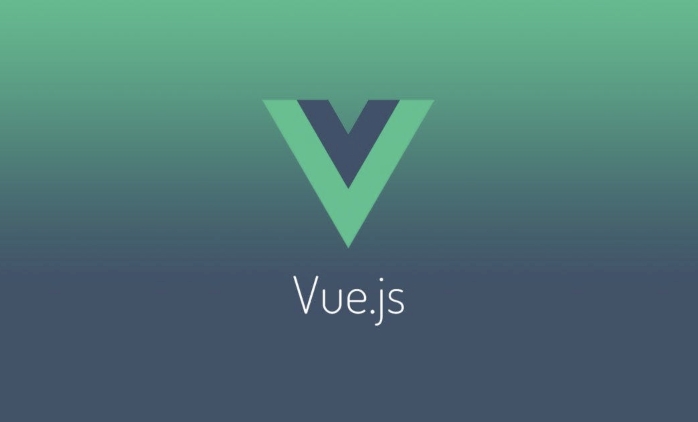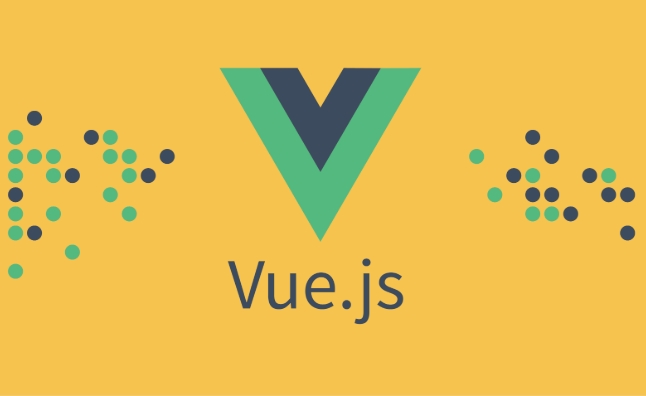如何处理VUE中的表格和验证?
使用v-model绑定表单数据以实现双向响应;2. 通过computed属性手动实现基础验证并显示错误信息;3. 对于复杂表单推荐使用VeeValidate结合Yup定义验证规则,提升可维护性;4. 优化用户体验应包括提交或失焦时校验、禁用重复提交、重置表单及显示加载状态,最终确保表单数据完整性和用户交互流畅性。

Handling forms and validation in Vue.js is a common task, and doing it well improves user experience and data integrity. Here’s how to manage it effectively using Vue 3 (Composition API), with or without external libraries.

1. Basic Form Handling with v-model
Use v-model to bind form inputs to reactive data. This keeps your form state in sync with your component’s data.
<script setup>
import { ref } from 'vue'
const form = ref({
name: '',
email: '',
password: ''
})
const handleSubmit = () => {
console.log('Form submitted:', form.value)
// Add submission logic (e.g., API call)
}
</script>
<template>
<form @submit.prevent="handleSubmit">
<input v-model="form.name" type="text" placeholder="Name" required />
<input v-model="form.email" type="email" placeholder="Email" required />
<input v-model="form.password" type="password" placeholder="Password" required />
<button type="submit">Submit</button>
</form>
</template>@submit.preventstops the page from reloading.v-modelprovides two-way binding.
2. Simple Inline Validation (No Library)
You can implement basic validation manually using computed properties or functions.

<script setup>
import { ref, computed } from 'vue'
const form = ref({
name: '',
email: '',
password: ''
})
const errors = computed(() => {
const errs = {}
if (!form.value.name) errs.name = 'Name is required'
if (!form.value.email) {
errs.email = 'Email is required'
} else if (!/^\S @\S \.\S $/.test(form.value.email)) {
errs.email = 'Email is invalid'
}
if (!form.value.password || form.value.password.length < 6) {
errs.password = 'Password must be at least 6 characters'
}
return errs
})
const isValid = computed(() => Object.keys(errors.value).length === 0)
const handleSubmit = () => {
if (isValid.value) {
console.log('Form is valid:', form.value)
// Submit logic
} else {
console.log('Form has errors:', errors.value)
}
}
</script>
<template>
<form @submit.prevent="handleSubmit">
<input v-model="form.name" type="text" placeholder="Name" />
<div v-if="errors.name" class="error">{{ errors.name }}</div>
<input v-model="form.email" type="email" placeholder="Email" />
<div v-if="errors.email" class="error">{{ errors.email }}</div>
<input v-model="form.password" type="password" placeholder="Password" />
<div v-if="errors.password" class="error">{{ errors.password }}</div>
<button type="submit" :disabled="!isValid">Submit</button>
</form>
</template>
<style>
.error {
color: red;
font-size: 0.8em;
}
</style>This approach works well for small forms and gives you full control.
3. Using a Validation Library (Recommended for Larger Apps)
For complex forms, use a library like VeeValidate with Yup for schema-based validation.

Install dependencies:
npm install yup @vee-validate/rules @vee-validate/form @vee-validate/yup
Example with VeeValidate Yup:
<script setup>
import { useForm } from 'vee-validate'
import * as yup from 'yup'
// Define schema
const schema = yup.object({
name: yup.string().required('Name is required'),
email: yup.string().email('Invalid email').required('Email is required'),
password: yup.string().min(6, 'Min 6 characters').required('Password is required')
})
// Use form
const { defineField, handleSubmit, errors } = useForm({
validationSchema: schema
})
const [name, nameAttrs] = defineField('name')
const [email, emailAttrs] = defineField('email')
const [password, passwordAttrs] = defineField('password')
const onSubmit = handleSubmit((values) => {
console.log('Valid form data', values)
})
</script>
<template>
<form @submit="onSubmit">
<input v-model="name" v-bind="nameAttrs" type="text" placeholder="Name" />
<div v-if="errors.name" class="error">{{ errors.name }}</div>
<input v-model="email" v-bind="emailAttrs" type="email" placeholder="Email" />
<div v-if="errors.email" class="error">{{ errors.email }}</div>
<input v-model="password" v-bind="passwordAttrs" type="password" placeholder="Password" />
<div v-if="errors.password" class="error">{{ errors.password }}</div>
<button type="submit">Submit</button>
</form>
</template>Benefits:
- Reusable validation schemas
- Built-in rules (email, min, max, etc.)
- Async validation support
- Better error handling and UX
4. Tips for Better Form UX
- Show errors on blur or submit, not on every keystroke.
- Disable submit button when form is invalid or submitting.
- Reset form after successful submission:
form.value = { name: '', email: '', password: '' } - Use loading states during async submits.
- Provide clear error messages.
Basically, start simple with v-model and manual checks for small forms. As complexity grows, switch to VeeValidate Yup for maintainable, scalable validation. It’s not hard to set up and saves a lot of time down the road.
以上是如何处理VUE中的表格和验证?的详细内容。更多信息请关注PHP中文网其他相关文章!

热AI工具

Undress AI Tool
免费脱衣服图片

Undresser.AI Undress
人工智能驱动的应用程序,用于创建逼真的裸体照片

AI Clothes Remover
用于从照片中去除衣服的在线人工智能工具。

Clothoff.io
AI脱衣机

Video Face Swap
使用我们完全免费的人工智能换脸工具轻松在任何视频中换脸!

热门文章

热工具

记事本++7.3.1
好用且免费的代码编辑器

SublimeText3汉化版
中文版,非常好用

禅工作室 13.0.1
功能强大的PHP集成开发环境

Dreamweaver CS6
视觉化网页开发工具

SublimeText3 Mac版
神级代码编辑软件(SublimeText3)
 如何管理VUE项目中的环境变量
Aug 22, 2025 am 11:38 AM
如何管理VUE项目中的环境变量
Aug 22, 2025 am 11:38 AM
环境变量管理在Vue项目中至关重要,需根据构建工具选择正确方式。1.VueCLI项目使用VUE_APP_前缀的.env文件,通过process.env.VUE_APP_访问,如.env.production;2.Vite项目使用VITE_前缀,通过import.meta.env.VITE_访问,如.env.staging;3.两者均支持自定义模式加载对应文件,且应将.env.local类文件加入.gitignore;4.始终避免在前端暴露敏感信息,提供.env.example供参考,并在运行时校
 如何将GraphQl与Vue和Apollo客户端一起使用
Aug 16, 2025 am 03:06 AM
如何将GraphQl与Vue和Apollo客户端一起使用
Aug 16, 2025 am 03:06 AM
安装ApolloClient和相关依赖包并根据Vue2或Vue3配置客户端;2.在Vue3中通过provideApolloClient提供客户端实例,在Vue2中使用VueApollo插件;3.使用useQuery和useMutation组合式API在组件中发起查询和变更;4.通过变量和refetch实现动态数据获取与刷新,可选轮询更新;5.利用loading和error状态优化用户体验,结合Suspense或防抖提升交互流畅性;6.通过HTTP链接头添加认证信息,使用缓存、片段和查询文件组织提
 如何在VUE 3中使用Teleport
Aug 20, 2025 am 10:30 AM
如何在VUE 3中使用Teleport
Aug 20, 2025 am 10:30 AM
teleportinvue3allowsrenderingAcomponent'stemplateInAdifferentDomLocationWhilePreservingItSlogicalPositionIntheComponentTree; 1.ItusestHecomponentWithatoTaToTributesPecifitutesPecifieingThetArgetDomnodeDormengetDomnode,supsas as asas as as s suesAs“ body” body'或“#modal-root”或“#modal-root”; 2.theteleport; theteleported;
 VUE中的手表和计算属性有什么区别?
Aug 22, 2025 am 06:03 AM
VUE中的手表和计算属性有什么区别?
Aug 22, 2025 am 06:03 AM
Usecomputed Properties WhenderiveReactiveValuesFordisPlay,AstheyAreCachedDandonlyre-evaluate-WhendependependencenciesChange; 2.UseWatchForexeCutingsIdeEffectSlikeCectSlikeCicallSorupDatingStorgeStorageInresetodatoreSeteToDatachanges
 如何在VUE中创建功能组件
Aug 22, 2025 am 05:11 AM
如何在VUE中创建功能组件
Aug 22, 2025 am 05:11 AM
功能组件在Vue2中用于创建无状态、高性能的展示型组件,适用于仅依赖props的场景。1.定义功能组件需设置functional:true,并通过render函数接收props和context返回VNode。2.使用时像普通组件一样注册并传入props和事件。3.处理插槽需从context中获取slots()和children。功能组件不适用于需要响应式数据、生命周期钩子或v-model的场景。Vue3中已移除functional选项,改用函数式写法或简洁的组合式组件替代,性能优化更依赖Comp
 如何使用VUE本机创建移动应用
Aug 25, 2025 pm 02:25 PM
如何使用VUE本机创建移动应用
Aug 25, 2025 pm 02:25 PM
使用VueNative创建移动应用是利用Vue.js语法结合ReactNative实现跨平台开发的有效方式;2.首先配置开发环境,安装Node.js、ExpoCLI,并通过命令npxcreate-react-native-appmy-vue-app--templatevue-native创建项目;3.进入项目目录并运行npmstart,通过ExpoGo应用扫描二维码在移动设备上预览;4.编写.vue文件组件,使用、和结构,注意采用小写的ReactNative组件如view、text和button
 如何使用Vue 3的构图API使用打字稿
Aug 08, 2025 am 10:27 AM
如何使用Vue 3的构图API使用打字稿
Aug 08, 2025 am 10:27 AM
使用Vite创建支持TypeScript的Vue3项目;2.用defineComponent提供类型推断;3.使用简化代码;4.用接口或类型定义props;5.用类型联合正确声明emits;6.在可组合函数中使用泛型;7.使用InjectionKey类型化provide/inject——通过这些步骤可实现类型安全、可维护的Vue3 TypeScript应用,最终构建出强大且可扩展的前端项目。
 如何在VUE中使用故事书进行组件开发
Aug 15, 2025 am 12:35 AM
如何在VUE中使用故事书进行组件开发
Aug 15, 2025 am 12:35 AM
安装Storybook可通过npxstorybook@latestinit自动完成,或手动安装依赖并配置.storybook/main.js和preview.js;2.编写故事文件(如Button.stories.js)定义组件不同状态,使用Template绑定参数生成多个实例;3.利用Args和Controls实现属性动态调整,提升交互测试效率;4.通过MDX文件整合文档与故事,增强可读性和协作性;5.建议将故事文件与组件共置、采用CSF格式、集成Chromatic进行视觉回归测试,并使用装饰







